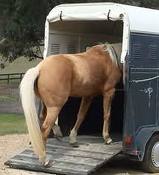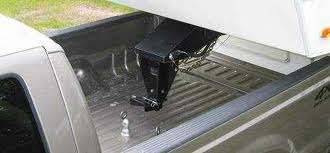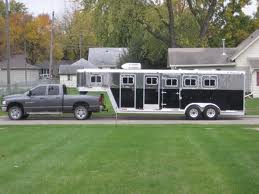|
Horse Trailering TipsWhen horse trailering, safety of the horse and people is paramount. Proper planning, preparation and maintenance prior to the trip will ensure a safe and successful horse trailering journey. This article provides information and guidelines to ensure a safe trip to your next destination. Slant load trailers have become a popular choice for equine transport. In today’s mobile horse industry, horses are trailered as part of a daily routine at many horse operations.

The primary destination is probably horse shows, but horse owners also have to trailer horses to veterinarians, farriers, breeding farms or to a trail for an enjoyable ride. A horse that will not trailer has limited usefulness. Many considerations and decisions have to be made to trailer your horse properly and safely. The vehicle to pull the trailer, the type of trailer and training the horse to load and trailer are important considerations that need to be addressed when horse trailering.
Vehicle For Horse Trailering
There are several important things to consider when selecting a vehicle to pull a trailer. These include things such as truck and engine size, brake and electrical systems, type of hitch and correct ball size. However, safety is the key factor. Engine size and gear ratio to provide adequate power and subsequent pulling ability are critical in transporting your horse. Power to climb hills safely and accelerate when necessary is crucial, particularly on long trips. Conversely, properly maintained and well-adjusted braking systems will provide adequate stopping ability. The brakes, along with a towing suspension or heavy duty suspension, will give a safe and gradual stop when horse trailering. An electrical system that provides not only for trailer lights but also electrical trailer brakes is absolutely necessary.
The vehicle exhaust system should be diverted to the side to prevent exhaust fumes from blowing directly into trailer vents. In addition, this will prevent engine sparks from being blown directly onto the trailer. Transmission coolers are available as add-on equipment to reduce wear on automatic transmission. Standard transmissions in vehicles should be four speed to reduce clutch and engine wear.

The vehicle must have a safe, sturdy hitch. The hitch must be well-attached, bolted and welded to the frame. Gooseneck-type hitches should be attached not only to the truck bed but also to the frame under the bed. Bumper-pull trailer hitches should be attached to the frame. Do not attach the hitch to the bumper only. Furthermore, safety chains are an absolute necessity. Safety chains further attach the trailer to the vehicle, and their use is required by law in some states. The chains should be permanently fixed to the trailer and attached to the frame of the towing vehicle if possible. They should be long enough to allow for adequate turning; however, they should not drag on the road surface. Simply looping the safety chains over the ball of the vehicle is unacceptable. Trailer hitches and safety chains should be properly secured before horse trailering. The height of the hitch should be adjusted to allow the trailer to run level down the road. An accurate method to estimate proper hitch height can be accomplished by placing a loaded trailer on the bumper on the vehicle. Each vehicle has a different level of spring absorption, which affects the height of the trailer/vehicle coupling.
The size of the ball on the hitch should match perfectly with that of the trailer. Always use the proper size ball and periodically check the ball and hitch for abnormal wear. A light coat of heavy-weight grease on the ball reduces friction and abnormal wear. Many horse owners put a cover on the ball to keep it from rusting. Trailer balls commonly come in sizes from one and seven-eights to 21/4 inches. There is a wide variation in quality, and often the cheap balls will have an inadequate stem size to accommodate successful horse trailering. The higher quality balls will have a larger stem diameter to provide extra strength. In addition, the stem of the ball must fit exactly the diameter of the hole in the hitch.
Trailer Selection The keys to selecting a horse trailer are comfort and safety. The trailer must have adequate length, width and height to accommodate the body type or breed of the horse. In addition, strong floors, mats, padding, ventilation and overall trailer design are important factors to consider when selecting a horse trailer. It is difficult to provide exact dimensions for all horses, but certain guidelines can be followed for horse trailering.
There should be ample length to allow the horse to stand solidly on all four feet without being cramped. An additional amount of room should allow the horse slight movement back and forth between the front of the trailer and “butt bar.” This should allow the horse enough space to brace itself. A rule of thumb would provide a trailer that is 10 inches taller than the normal resting position of the head. The trailer width should provide enough space to allow 3 inches of lateral movement on each side of the horse. A trailer that provides a 30-inch wide area may be fine for an Arabian, but might be much too narrow for a heavy-muscled Quarter Horse. The more comfortable a horse is in a trailer, the less likely it will develop bad trailering habits.
Trailer lights are required by law and are needed for visibility and to indicate changes in trailer movement. Furthermore, trailer brakes are recommended for all trailers that are towing horses. A good, safe braking system, as well as adequate trailer lights, are critical safety features that cannot be ignored. A variety of floor types can be used successfully in horse trailers. The primary considerations are strength and safety. Rotten boards or boards slick from urine can cause permanent injury to horses.
Horse Trailering Rubber mats, wood shavings and straw are excellent materials to cover the wood floors. These floor coverings provide extra cushion and comfort for the horse. Wood shavings and straw also provide absorbency for urine and feces. A mixture of wood shavings and straw is an excellent floor covering. Rubber mats should be removed periodically from the trailer to allow the wood to completely dry. Ideally, rubber mats should be removed whenever the trailer is not in use. Urine or water trapped between the mat and the wood causes the wood to rot, decreasing the life of the trailer floor. Wood shavings should also be removed to protect the floor and allow it to dry. The floor should be constantly checked for weaknesses or to find other problems that could endanger the horse.
It is generally advisable to separate horses inside the trailer. The horses can be separated by a solid divider that is approximately 4 feet tall and extends the entire length of the trailer. This divider fits flush with the floor and the horse is completely protected from another horse. However, a disadvantage of a solid divider is that it may not allow a horse adequate width to brace itself, particularly in a narrow trailer.
Conversely, a partial divider that does not go all the way to the floor allows for a wider stance for bracing. A disadvantage of a partial divider is the possibility of injury to the other horse by its traveling companion stepping on it. Also, a mare and foal are more difficult to haul with a partial divider, but this depends on the distance the divider is off the floor.
A spare tire should always accompany the trailer and is not always part of the standard equipment. Proper tire inflation should be maintained at all times. The correct size jack to lift the vehicle or trailer should be properly stored for the trip. In addition, proper lug wrenches to remove the spare tire and wheel from its holder and the vehicle or trailer tire are necessary to prevent a long delay caused by a flat tire. The size of lug nuts on the spare tire and wheel may differ from those on the ground.
Every trailer should have a “butt bar,” or chain behind each horse. This provides a safety mechanism in case the door comes open or was not properly fastened. The horse puts weight on the butt bar rather than the trailer door. This is standard equipment on most trailers built today. Butt bars and chains can be padded and wrapped to help prevent rubbing hair from the tail.
The trailer should be well-padded to prevent injury to a horse in case of a sudden stop or accident. The padding should be on both sides, front and rear of the trailer. Padding should be low enough to protect the knees in front and adjusted properly to prevent rubs on the sides of horses. A well-padded trailer is simply another safety factor to consider when horse trailering.
Another decision to make is whether to select a trailer with a loading ramp or one where the horse simply steps up to enter the trailer. Either one is satisfactory, and horses can be trained to load either way. There is generally an extra cost for the ramp-type versus the step-up type trailer. The loading ramp should be gently sloping and not too steep for the horse. It should be strong with secure footing on the ramp to prevent the horse from slipping. It is extremely important for the ramp to be solid and well attached to prevent a hollow sound. Many horses become frightened when trying to walk on a ramp that makes a loud noise. It is generally easier to load a foal or young horse with a ramp as opposed to the step-up.
Step-up trailers are the most plentiful type of trailer. Horses simply step up to enter the horse trailer. Step-up trailers should be low enough to the ground for the horses to maintain proper footing when loading. Also, the step-up ledge on the back of the trailer should be rounded to prevent knee or hind leg injury if the leg slips under the trailer when the horse is being loaded.
Proper ventilation is a must for any horse trailer. Horse trailers that are totally enclosed should have overhead, side and rear door vents to allow for adequate ventilation. Many of these trailers will have removable upper rear doors. Four horses in a horse trailer give off a tremendous amount of heat, presenting a real problem in the summer. Even in the winter, horses need ventilation. Chances are much greater of overheating in the summer than of getting too cold in the winter.
Trailers are manufactured to allow horse owners a choice between those in which horses ride on the slant, head-to-tail or head-to-head. In the slant load trailer, horses are loaded side by side on the slant with a divider. This is rapidly becoming the most popular trailer type in the industry. Horses seem to ride more easily and with significantly less trailering stress. On the slant, horses are more stable during stops and starts.
Horse Trailering
The traditional nonpartitioned stock-type trailers are still an effective and safe way to transport horses. Horses can be tied head-to-tail, head-to-head, or probably the more practical, on the slant to the sides of the trailer. The key to avoiding injuries to the horses is to limit the number of horses in the trailer. Do not overcrowd. The stock-type trailer remains a safe and popular way to haul a mare and foal.
The mare and foal should have plenty of room while they are being trailered. The horse owner should not tie either the mare or foal. If a two-horse trailer is used, the center partition should be removed to allow for more room and safety. It is mandatory that the trailer be enclosed totally, especially above the rear doors. Many foals have been lost or injured by jumping out of a moving trailer. Good trailer driving is essential when hauling any horses, but especially for a mare and foal. Avoid sudden stops and starts that may cause a mare to step or fall on a foal. A well-bedded trailer will also give better footing and dryer conditions for the mare and foal.
Summary Although there are a multitude of vehicles and trailers that can adequately transport horses, safety for the people and the horses is paramount. An experienced driver will continuously evaluate the condition of the horses in the trailer and make appropriate adjustments. Proper planning, preparation and maintenance prior to the trip will ensure a safe and successful journey.
Source - DG. Meadows, Horse Trailering
Return from Horse Trailering to Horse Riding Connection
|
 The weight and size of the vehicle should be appropriate to the size and load of the trailer. Do not use a vehicle too big or small for the trailer. For example, a half-ton truck may pull a two-horse trailer adequately but is much too small for a six-horse van. It is also not advisable to pull a two-horse trailer with a one-ton truck. In this case, it is not easy to feel movement in the trailer and there is a tendency to pull the trailer too fast. Some vehicles, particularly those with a short wheelbase and all-wheel drive, will have enough power to tow a trailer but may lack the safety of other vehicles. Some of these vehicles have a tendency to turn over more easily and exhibit less stability on the road because of the high center of gravity.
The weight and size of the vehicle should be appropriate to the size and load of the trailer. Do not use a vehicle too big or small for the trailer. For example, a half-ton truck may pull a two-horse trailer adequately but is much too small for a six-horse van. It is also not advisable to pull a two-horse trailer with a one-ton truck. In this case, it is not easy to feel movement in the trailer and there is a tendency to pull the trailer too fast. Some vehicles, particularly those with a short wheelbase and all-wheel drive, will have enough power to tow a trailer but may lack the safety of other vehicles. Some of these vehicles have a tendency to turn over more easily and exhibit less stability on the road because of the high center of gravity. 